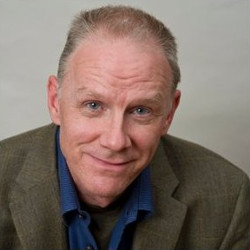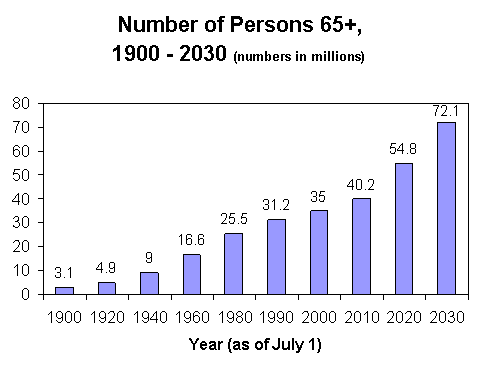
Eldercare Village Building Guidelines
<http://lily-old.org/LiLY-webpages/Eldercare-Village-Building-Guidelines.shtml>
(Photo courtesy of John H)
Table of Contents
Don’t Do
How to Build
an Eldercare Village
In the spring of 2009, Irene Zola, founder of Lifeforce in Later Years (LiLY), thought about how a group of volunteers could help care for vulnerable seniors in their own homes. Next, she did extensive research and, only then, began to help organize her community.
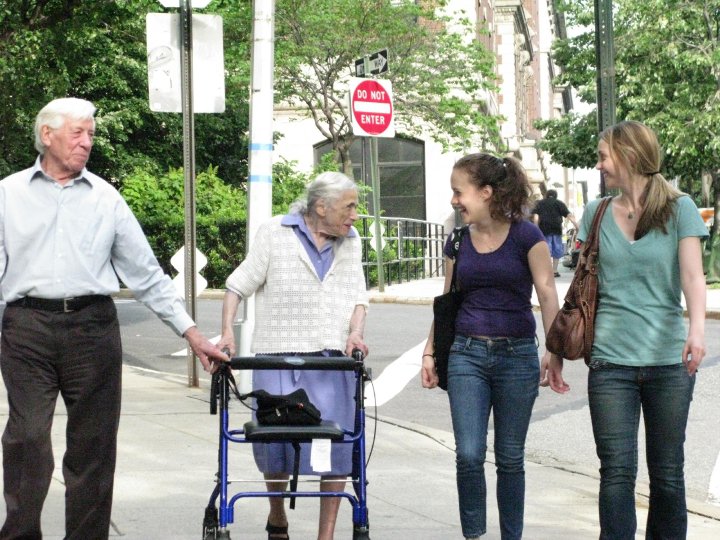
Morningside Villagers on a Stroll
The end result is LiLY’s Morningside Village, which is a thriving care community within a 30-block zone in Manhattan. Through a series of steps, some bringing Morningside Village closer to its goals than others, Irene and a group of other volunteers found success. Now, Morningside Villagers and advisors have created general guidelines meant to help you with eldercare village-building, no matter where you live.
Our Mission
We are dedicated to helping frail older seniors to age in the comfort of their homes and communities, where they want to be, whenever possible.
Background
Morningside Village was the first project of LiLY, Lifeforce in Later Years, Inc., a nonprofit organization qualifying as a federal Section 501(c)(3) Organization, in response to the dire challenges facing a good majority of frail elderly people today, mostly on limited incomes. Founded in 2009, Morningside Village is a new community-based program, modeled to some degree on other such networks, e.g., Capitol Hill Village in Washington, D.C. and Beacon Hill Village in Boston, MA. Morningside Village was developed by a team of committed neighbors in the Morningside Park – Columbia University area of Manhattan, creating a cadre of ready, willing, and able volunteers to help frail elders who want to live at home as they grow older. There are philosophical underpinnings that distinguish Morningside Village from its predecessors; and there are practical differences as well.
Although most other similar Villages require membership fees from those served, Morningside Village is not a membership organization, and those served are served free of charge. Founders believed that succeeding generations are indebted to the eldest of us for their combined legacies; hence, they are not charged for the friendship and help that they receive as Morningside Village elders.
Another way that Morningside Village differs from other “Villages” has to do with location. When volunteers began to build the Village, we learned primarily of the existence of other “Villages” on the outskirts of cities or in suburbia.
None were in a metropolis, where the needs that very old people have are related more to isolation and less to raking lawns and such. In an environment where there are no one-family homes, and where janitors are available to serve some of the needs of residents, such as shoveling the snow outside of the apartment building or even screwing in a light bulb, the role of volunteers is different to some degree. They sometimes do errands and help to scout out helpful devices,
Google Map
of the
Morningside Village Geographical Area.
but more often they function more or less as encouraging and supportive neighbors, connecting the elderly to services and figuring out confusing issues as well as offering a friendly arm for walking up a slope. One elder often says, “This is not an arm; it’s a heart!” In fact, over time, volunteers found that those elders served mostly had no close family members living within 80 miles. So, it was felt that volunteers, especially some, were filling in for absent families. Founders agreed that, under the circumstances, it would be difficult to charge low income elders for these activities. Rather, it would be important to focus on other means of fundraising. (See Seek Funding.)
Since June 2009, Morningside Village has enlisted volunteers and has been offering welcomed help to vulnerable elders living in the area bordered by West 108th Street, Riverside Drive, West 118th Street, and Morningside Drive, a neighborhood where well over 2,000 seniors reside, hundreds 85 years old and over. In addition to our committed volunteers, we invite neighborhood stores, organizations, schools, and institutions to become active members of our Morningside Village program, with resources of all kinds. We do help supply elders with referrals for resources; such as, social services, visiting doctors, or professional assistance, where appropriate.
Why We Do It
Experts tell us that over 12% of the population is now 65 years old and over. And, the numbers are expected to double in the coming few decades. In addition, we have found that octogenarians and nonagenarians are often living close to the poverty line, even when they have lived much of their lives as middle class income earners. So, at a time when health costs are rising, when government health subsidies are declining, when there are far too few geriatricians, when families are living at great distances, when baby boomers are retiring, and when people are living longer, we can expect a looming crisis in eldercare.
In addition to these factors, volunteers say they feel that they are helping to “pay back” the oldest of us for the legacies that they continue to provide to succeeding generations. Without them, we would not be where we are today.
These factors, coupled with the knowledge that, as many of us have found out from first hand family experiences, very few elders wish to live out their years in a traditional nursing home. For in them, needs are often met by caregivers in aggregate. We at LiLY believe there is a strong need for a radically new way to provide people with life-affirming eldercare.
Who We Are
Here is a Google Map of the Morningside Village Catchment Zone.
What We Do
Morningside Village is involved in a plethora of outreach activities. It attracts, screens and trains volunteers. We also identify and approach seniors in need. Finally, it reaches out to community leaders and entrepreneurs.
We are flexible in the help that we offer to elders. Our volunteers stand ready to provide practical help through
- Linking seniors to the healthcare and social services that they need;
- Assessing the home environment;
- Helping with home management issues and providing support of all kinds;
- Telephoning, where trouble-shooting is required;
- Helping to care for pets;
- Supporting medical management issues, e.g., regularity with taking medicine;
- Ironing out confusing or complicated issues;
- Connecting older seniors to the community;
- Accompanying seniors on outings where wanted;
- Providing friendship and encouragement;
- Creating wanted activities, engagements, and entertainment;
- and more.
On a continual basis, we coordinate, oversee, and assess the program and the needs of our volunteers and elders.
What We Don’t Do
We do not market or sell products or services to our elders. The information we learn about our elders is private and confidential. We do not share information with commercial entities or with others, unless instructed by the elder. While we have many skills among our volunteers, we are not paid professional service providers and do not offer the services of professionals such as medical or financial.
A thriving Eldercare Village may begin in the mind of just one resident. In the case of Morningside Village, it only took one motivated person to set the Village in motion!
What To Do First: Research
Reasons for spending time finding information:
- You will locate resources.
- You will acquire the language that will help you to best communicate with people who can help you.
- You will better be able to understand and help, volunteers, seniors and, where they exist, their families.
General Research
- Search for a pro bono lawyer to help you attain nonprofit status and/or seek out a nonprofit organization with a related cause that will serve to accept donations and grants on your organization’s behalf. For example, in NY State we were able to locate an organization, New York Lawyers for the Public Interest (NYLPI), which acts as a clearing house for legal firms that are seeking to provide pro bono services for nonprofit organizations. NYLPI publishes a newsletter, Pro Bono Matters, describing various nonprofit projects and disseminates the information to legal firms (see also below).
- Search the Internet for background about aging and the elderly, including national and local data; the International Longevity Center USA is an excellent information source; so is the Administration on Aging (AoA), the Federal agency responsible for advancing the concerns and interests of older people and their caregivers. For example, in the AoA’s publication “A Profile of Older Americans: 2009” under Future Growth you will find that in 2007 the 65 and over population was 12.6% of the entire national population; and it is estimated that in 2030, it will be almost 20% of the population.
- Learn what the demographics and sociological data are telling us about seniors.
-
Consult national
census data
(free and public) and voting records
because a relatively high percentage of elders
are registered to vote
(small fee of a few dollars for this information).
You can find out how many seniors live in your small Village
catchment zonenow, and then each time you expand the zone.catchment zone is a term Morningside Village has taken from Human Geography to denote the geographical area whose inhabitants Morningside Village attracts and serves.
Here is a Google Map of the Morningside Village Catchment Zone. - Collect specific local information; for example, what stores, facilities, institutions and organizations are in your area: if in a city or town, on a block-to-block basis; if you live in a hamlet or sparsely populated area, you will need to collect information on a different basis. In fact, your Eldercare Village may consist of several relatively nearby volunteers organizing to help one or just a few frail seniors, at least for beginners. So, you may want use a 3-mile radius as your starting point, or even 10 miles, rather than one side of one city block as we did.
- Visit the Foundation Center online and other possible funding sources, including state and local government web sites, to learn about fundraising. The Center has partnerships with institutions all over the nation where you may be able to visit and use its resources free of charge.
- On the internet and through a visit to your local library, find out all you can about fundraising. Often there are films and other forms of information on fundraising for nonprofits readily available, free of charge. For example, we saw a helpful film in a library that demonstrated ways of talking to a potential donor.
Finding Out About Who You Are Working With
- Volunteers There are many reasons why people volunteer: they may be dedicated to the cause of frail elderly folks; they may be seeking to become more integrated into the community, and more. Once volunteers have linked up with you, they will have other needs as well: perhaps the need to know something about seniors, or something about visiting a stranger, or about what will be expected of them. They may also have the need to discuss specific situations or issues that come up for them in the course of volunteering. There’s lots of literature on the web about the subject of volunteering; and you will want to look at the needs of volunteers on many levels.
- Elders Who Need Help — Living Alone Many frail seniors live alone in their own homes because they have outlived nuclear families or have families living at a distance and cannot afford the price of hiring live-in companions/care-givers. Too few live with a family member or friend who is acting as care-giver, and in those cases the care-giver can experience the need for respite (which your Eldercare Village can help provide). Elders often do not want to tell their grown children about their needs for help. Some verbalize their wishes not to be a burden on their families or anyone else. Some fear being sent off to a nursing home. Some may fear unwanted government intervention, so they may be suspicious of the stranger. It may be advisable to take baby steps in relationship-building before a senior will trust a volunteer — For each senior, there will be a different pace of engagement, and sufficient primary research (involving the particular seniors) will give you the answer as to what that pace is.
- Families of the Elder Some families will be happy to learn that volunteers are forming relationships of care with their elderly loved ones, and they may express their appreciation from time to time. But, volunteers may find that in some cases the senior does not particularly wish for the volunteer to form a relationship with his or her family; or the volunteer may find that a particular family is not interested in knowing much about the volunteer program. There are probably many reasons for families’ welcoming reactions to volunteers in the lives of the elderly, and many reasons why families sometimes do not show interest. Rather than write a chapter about this topic here, members of each Village project may want to think about whether it is important to have an in-depth understanding about the relationships volunteers do or don’t have with the families of seniors.
Phase Two
Reaching Out Into The Community
How to Talk About What You Are Doing
When you begin to communicate with people about your Eldercare Village, at first, words to explain yourself may not come easily.
You will probably want to tell friends about what you are doing, and this is a good way to practice for when you speak with strangers. To be sure, after a few goes, you will begin to feel comfortable talking about your work, and your enthusiasm will be contagious.
How to be Considered a NonProfit Organization
You will want to form an official corporation in your state, so that the organization, not you, is responsible for the organization’s activities. You will also want your organization to become an official not-for-profit organization, with federal tax exemption status, a 501(c)(3) status. This way, the organization will become more attractive to potential donors. Without the benefit of a lawyer, achieving these ends can take a very long time indeed. Thus, it is suggested that you seek out a reliable pro bono lawyer who will create these documents with you. There are organizations in many states that can help you to find such a lawyer. For example, in NY State, there is the New York Lawyers for the Public Interest organization that functions as a clearing house for charitable organizations like yours that need to find a free lawyer (see also above).
It will take a few months before you receive your official nonprofit corporation status. But in the meantime, there is much you can do in other areas to move the wheels of progress.
There is another way to be considered a nonprofit organization. Contact an organization that is already an official nonprofit organization and ask its Board if it will form a special relationship with your “Village”. This relationship, know as Fiscal Sponsorship, might be compared to parent and offspring for legal purposes, where the nonprofit will receive tax-deductible income on behalf of your Village. The “parent” organization should have a mission that dovetails with that of your Village, for example, a nonprofit community development organization. We recommend that the Fiscal Sponsorship approach not be seen solely as a substitute for your Eldercare Village eventually acquiring its own, independent, non-profit status with the IRS. However, it could be a great way to setup and start your funding while waiting for the IRS to complete its process of awarding 501(c)(3) nonprofit status to your Village.
A good, short introduction is “How Fiscal Sponsorship Nurtures Nonprofits”. The Fiscal Sponsor Directory is one of the web sites to help connect community projects with fiscal sponsors. The Foundation Center has these two resources: “What is fiscal sponsorship? How do I find a fiscal sponsor?” and “Guide to Fiscal Sponsorship”. The Network for Good also has some good tips in its “Finding a Fiscal Sponsor”.
Decide on the Geographic Size of Your Eldercare Village
You have a lot to consider as you plan the borders of your original Village. As the Village grows, organically, increasing the size of its volunteer group and capacity, you may expand its borders. In Morningside Village in New York City, we began with one block, and after a month we expanded to a 12-block zone. After several months, we expanded to a 24-block zone. And, currently, we believe that our zone has reached capacity at 30 blocks. Note, inside of the 30-block zone, there are areas where there are no or few residents served, for example a large cathedral and adjoining park, which takes up three city blocks and a hospital, which takes up two.
A spread-out community is dependent on transportation, of course. If you live in a sparsely-populated community, you have your work cut out. At first, you must decide on a zone which includes at least one elder and several possible volunteers. The more people involved, the more attractive your Eldercare Village will be to helping partners. So, you may want to draw your boundaries to include as many elders as possible with as many potential volunteers as possible, but not so spread out that it will take more than, say, twenty minutes to travel between volunteer and senior. Also, you want to consider including many institutions, shops, and organizations that could become vital resources. You may want to draw your boundaries to include a hospital, if possible, or a college or social service agency, or all of the above and more. If your base is very far from any of these institutions, you may need to form relationships with the closest of them at any rate. You may need to convince Directors of these entities of the importance of partnering with your organization, despite the geographic distance, perhaps arranging for a visiting doctor program with a hospital, or other door-to-door services where needed all in good time. During the first year, Morningside Village created a cadre of 50 volunteers serving 32 older seniors. If your community is spread out, your first year’s achievements may be more modest: 25 volunteers serving 15 older seniors, or even less.
Here is a Google Map of the Morningside Village Catchment Zone.
- Neighbors who, through experience, have learned that it’s time to forge new ways of providing eldercare;
- Local organizations and institutions, such as a hospital, a library, colleges (especially ones with Social Work schools), and religious centers;
- A local Social Services organization with licensed social workers and service providers;
- Business leaders, store owners, and service providers;
- Local offices of government officials, including city, state, and federal representatives.
Create a Literature: A Newsletter, flyers, a brochure
For an example of a newsletter sidebar, see our “Morningside Villager” newsletter.
If you have the resources, you may want to create a general brochure about your organization, which you can use in all kinds of situations … in the community, for volunteers, elders, their families, and prospective donors. Morningside Village also created separate flyers to attract older seniors and volunteers.
Form a Cadre of Ready Volunteers and Set them to Work
- Name Your Village Decide on a name for your Eldercare Village. Obviously, you won’t want to choose the same name as your town or village. We chose a name that we felt was upbeat and was the name of a neighborhood park and street, “Morningside”.
- Create a Recruitment Meeting Place and Time Decide on the place and time to meet with prospective volunteers and reserve a meeting space. For Morningside Village, we decided on a weekday evening at 6pm and to serve light refreshments. We asked a church for the first meeting and a local school for a second meeting space. Mentioning affiliations that one of our organizing friends had with the church and another had with the school, in both cases, we received affirmative responses and reserved a meeting space without a hitch. We got a local deli to contribute the refreshments by promising honorable mention in our literature.
- Create Literature Create literature, for example a newsletter, which explains the program and is meant to attract volunteers; include a time and place for the upcoming recruitment meeting; also create a volunteer application to give to interested people. As an example, here is a link to our newsletter, “Morningside Villager”. We also created a large Morningside Village sign for “tabling”.
-
Find the Right Place to “Table”

“Table” at a Busy Location
Begin “tabling”. Find a place where the most people congregate in your area. If you live in a place like New York City, Broadway may be as good a place as any if Broadway happens to be in your-

Here is an example of a busy spot ideal for “tabling” and recruiting new Village volunteers.
(Photo courtesy of John H) -
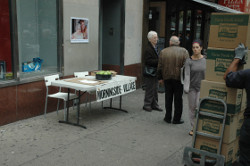
The location has the advantage of being near a subway station, bus stop, newspaper kiosk, and busy supermarket.
(Photo courtesy of John H) -
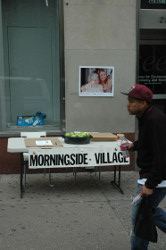
The many passers-by live in the neighborhood of the Village.
(Photo courtesy of John H)
Photo ofcatchment zone. There’s where you will want to set up an outdoor table and folding chair or two. Obviously, this is not something you want to do on a freezing day in winter. But if you are in a more spread out environment, you may consider the nearest mall, religious center, general store. (You may have to get permission.)catchment zone is a term Morningside Village has taken from Human Geography to denote the geographical area whose inhabitants Morningside Village attracts and serves.
Here is a Google Map of the Morningside Village Catchment Zone. -
-
What Does the Table Look Like?
Set up a table and add your literature and a sign,
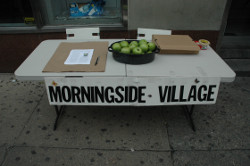
The Appearance of a Table
at a Busy “Tabling” Locationnaming your organization, e.g. “Lakeside Village”, perhaps with a large interesting photo of a senior.-
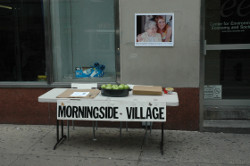
The large “MORNINGSIDE VILLAGE” sign, easily visible from afar, names the Village. To catch the human interest of passers-by, an enlarged photo of a youthful volunteer with her grandmother is taped to the wall above the table.
(Photo courtesy of John H) -

On the table from left to right are: Village newsletters and flyer handouts with pens lying on top of a large cardboard backing that can serve as a writing surface for filling out volunteer application forms; a bowl of organic, washed, green apples; and a box containing volunteer application forms. Not shown are the few rocks and other weights that are indispensible for holding down papers to the talbe on windy days.
(Photo courtesy of John H) -

The green apples were donated by a nearby supermarket, giving them a chance to get involved for some free word of mouth advertising. The apples act as a humorous and healthy, but important, lure for the people walking by. Many children are attracted by their bright colors, bringing parents in tow to the table.
(Photo courtesy of John H)
Photo of -
- Add An Attraction to the Table Convince a local supermarket to provide you with a free basket of washed apples to add to your table as a way to draw in passersby.
-
“Table” With Someone
If you don’t yet have even one volunteer
to help you with “tabling”,
ask a friend, spouse, family member or other
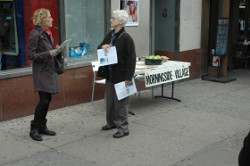
“Table” With Someone
to at least come along for the company and sit behind the table on a folding chair.-

Here are two volunteers of LiLY’s Morningside Village, Erin B and Marie K, with flyers in hand, teaming up for an afternoon of “tabling” to talk about their Village to passers-by and try to recruit them as new volunteers.
It’s always easier to “table” with one or more volunteers: for mutual encouragement, strategizing to try out new techniques, teaming up when several people approach the table, …, &c.
(Photo courtesy of John H) -
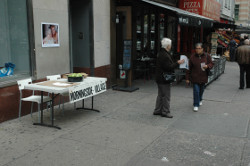
Marie K, flyer in hand, tries to interest a women approaching. Will she take a flyer with her free hand and perhaps stop to ask a question … ?
(Photo courtesy of John H) -
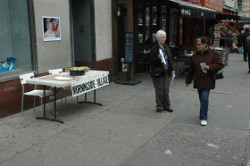
Nope, the woman walks on by.
(Photo courtesy of John H) -
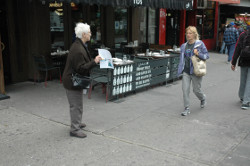
But Marie K is not discouraged, knowing not to take “rejections” personally and that, at least on the streets of New York City, most people don’t have time to stop and talk, and are even skeptical about accepting handouts.
Undiscouraged, Marie K is ready for the next passer-by …
(Photo courtesy of John H) -
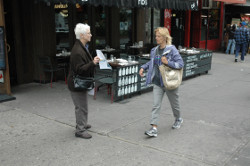
Will Marie K succeed? Perhaps, the passer-by is raising her right hand, as if about to grab a baton in a relay race …
(Photo courtesy of John H) -
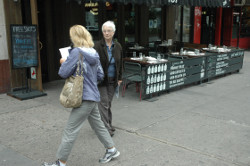
Yes! She grabs the flyer from Marie K without breaking her stride.
(Photo courtesy of John H) -
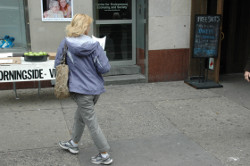
Looking back at Marie K, probably to say a thank you, her Nike jogging sneakers continue her stride without a change in direction … but the flyer in her hands has all the Village contact information, so Marie K chalks this up as a success!
(Photo courtesy of John H) -
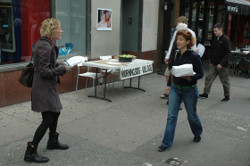
Let’s not forget about the other volunteer, Erin B. With a knee bent in anticipation, she is ready to talk to this passer-by holding a slice of pizza within a takeout bag in her left hand. (Note: the nearby pizzeria adds to the pedestrian traffic, an extra advantage of this location for “tabling”.)
Will Erin succeed with this passer-by … ?
(Photo courtesy of John H) -
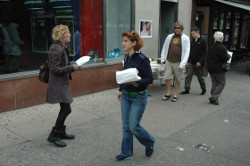
Nope, this passer-by has only pizza on her mind.
(Photo courtesy of John H) -
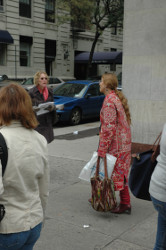
But like Marie K, Erin B does not take this failure personally (after all, she was competing with a slice of pizza).
Undeterred, Erin is ready, pen in hand, for this one! But this one must be a tough case. Carrying bags in both hands, she has no free hand to take a flyer or newsletter!
(Photo courtesy of John H) -
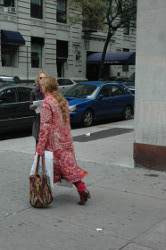
Full of optimism, Erin addresses the woman. Maybe it’s the coat that strikes a chord with Erin’s intuition …
(Photo courtesy of John H) -

Uh-oh, this one is about to get away!
(Photo courtesy of John H) -
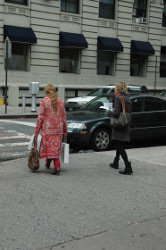
Going … going … will Erin give up and let this one get away?
(Photo courtesy of John H) -
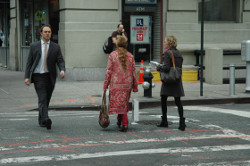
No, not yet. Erin accompanies the woman across the street, all the time talking about the Village, its goals, and the need for volunteers.
(Photo courtesy of John H) -
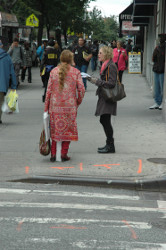
It’s working! Once across the street, the woman has put down her bag as Erin continues to explain the Village concept.
(Photo courtesy of John H) -
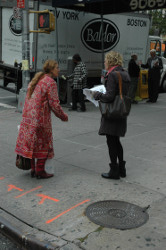
She reaches out her free hand …
(Photo courtesy of John H) -
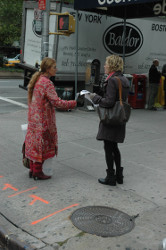
… to take a flyer from Erin …
(Photo courtesy of John H) -
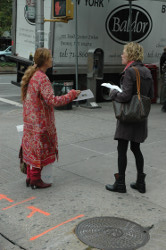
… she continues to listen …
(Photo courtesy of John H) -
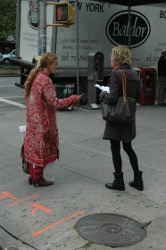
She reads the handout …
(Photo courtesy of John H) -
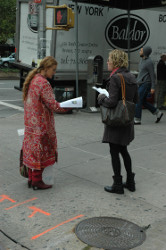
… flipping it over to read the back.
(Photo courtesy of John H) -
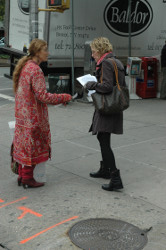
Erin persistence has paid off! It usually does when people listen to the Eldercare Village concept and understand its concept, timeliness, and need.
(Photo courtesy of John H) -
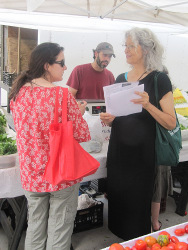
Here, Irene Z is "tabling" at one of New York City’s Greenmarkets , showing that any outside public location, with lots of people present, is a good location.
(Photo courtesy of
Adam Phillips )
Photo of -
- The How-to of “Tabling” There is an art to tabling: don’t just sit there; follow people who walk by letting them know that you are not asking for their money but are “organizing a team of volunteers to help look after the elderly in the community”, handing them a newsletter/flyer, which includes a date and place for a volunteer gathering; while you talk to people, others will be free to read the literature or speak with your co-organizer(s).
- Bring Applications Some people may want to fill out an application right then and there; others may want to wait; the main thrust of this activity is to get people to attend the volunteer recruitment meeting.
- How Much Time is Needed for “Tabling”? You may want to “table” for a couple of hours on a few days; distribute the newsletter on a house-by-house basis; leave copies on bulletin boards and other important places.
- How Many New Recruits Will be Needed? On the day of the first volunteer recruitment meeting, you may find that only one or a couple of volunteers appear. Have heart! They are the ones who will best help you to create the second such meeting. Even one new volunteer may be an important start to your organization (and don’t be surprised if a senior or two who need help show up — that’s how great the need is! Strategize. You may have to create a meeting at a different time of day, week/month/year or in a different meeting place in order to attract more people.
- Content of the Recruitment Meeting I like to begin meetings with a “go-around”, where everyone says their name and something about their interest in volunteering, if they want to. This way, the meeting becomes inclusive right away. Then the organizer(s) can talk first about the problem, perhaps something they’ve seen in their own experiences. They might want to say: “there are vulnerable elderly people in our neighborhood who need help in order to age in their own homes.” You might give a specific example. Then, explain the solution, what the Village will do to help the elders as well as to build community ties for all. This is usually followed by a Q & A period.
- Volunteer Application Have meeting attendees fill out application forms (name, contact info, times available, interests, two references w/contact info; we ask that these references consist of people who are not family, preferably employers, colleagues, etc.) But, they may not have time at the meeting; hence, be sure people sign in on a sheet with contact info.
- Check References As soon as possible after the application is completed (next day(s)), call references and ask enough questions to get a good idea of the applicant’s strengths, time known by recommender, and more. “How would you feel about the volunteer spending time with your own mother?” On the internet, you can find guidelines that will help you with a script. Just google “volunteer reference check questionnaire” or bing these keywords. Don’t forget, volunteers will be entering the homes of vulnerable seniors, so you want to hear as much as possible about the volunteer.
- Volunteer Insurance Be sure you purchase volunteer liability insurance. You may find an organization in your state that specifically recommends insurance agencies to nonprofits, like the New York Council of Nonprofits Inc., which helped us at Morningside Village. Insuring up to 50 volunteers cost us approximately $235 for the year. This provides our organization with a degree of security against claims of up to $1,000,000 for possible damage. (We never expect to be involved in such a claim, but we sure don’t want to cause trouble for ourselves should someone slip up.)
-
Volunteer Orientation Meeting
Next, set a time and place for a volunteer orientation meeting.
(We began by holding these meeting in people’s homes.
They can also be held at public places.
Ask religious institutions, public organizations
and even a bank or other commercial organization
if they will donate space for the meeting.)
At this “orientation” meeting, you will want to review a set of visiting guidelines for volunteers. We are publishing ours, which applies ONLY to Morningside Village in New York City, so please don’t use its contents verbatim. Our letter is signed by a Licensed Certified Social Worker, and she does not take responsibility of providing you with advice. At the meeting, we also train volunteers in use of a wheelchair although he or she may never need to help operate one. You may be able to borrow a wheelchair from someone or from a local hospital or nursing home for a few hours. A volunteer with wheelchair expertise can give instructions to the others. A local hospital or nursing home may agree to provide your group with a lesson on wheelchair use. There are videos on YouTube.com that also illustrate wheelchair use.
This is one example of an instructional video on wheelchair use produced by the Lone Star College in Kingwood Occupational Therapy Assistant Program Class of 2010.
-
Interview
Ordinarily, the
coordinatoror other seasoned volunteer will take the time to meet with a new volunteer before or shortly after she or he begins to visit an elder. This will help the coordinator to best get to know the strengths and weaknesses of a prospective volunteer and to match volunteers to elders.coordinator is a term Morningside Village uses to denote the person who matches up thevillagers andvillager is a term often used in Morningside Village for the seniors or elders who live there, to distinguish them from thevolunteers.volunteer denotes a person who is scheduled by acoordinatorfor regular visits with aThe definition of the term coordinator is already being shown.villager. Ideally, both the volunteer and theThe definition of the term villager is already being shown.villagerlive within the Eldercare Village, making it a true community; which is sometimes, more technically, referred to as aThe definition of the term villager is already being shown.catchment zone.catchment zone is a term Morningside Village has taken from Human Geography to denote the geographical area and its inhabitants which Morningside Village attracts and serves.
Here is a Google Map of the Morningside Village Catchment Zonevolunteers in terms of mutual interests, compatibility, and time scheduling.volunteer denotes a person who is scheduled by acoordinatorfor regular visits with aThe definition of the term coordinator is already being shown.villager. Ideally, both the volunteer and thevillager is a term often used in Morningside Village for the seniors or elders who live there, to distinguish them from thevolunteers.The definition of the term volunteer is already being shown.villagerlive within the Eldercare Village, making it a true community; which is sometimes, more technically, referred to as avillager is a term often used in Morningside Village for the seniors or elders who live there, to distinguish them from thevolunteers.The definition of the term volunteer is already being shown.catchment zone.catchment zone is a term Morningside Village has taken from Human Geography to denote the geographical area and its inhabitants which Morningside Village attracts and serves.
Here is a Google Map of the Morningside Village Catchment Zone -
Buddy System
Once volunteers have been recruited,
received stellar referrals from people who know them,
and have attended an orientation meeting,
they are ready for their first visit.
In Morningside Village
a new recruit is mentored
for his or her first three visits
by a seasoned volunteer.
Then, for future visits volunteers
may buddy up with another.
Reasons:
- One-on-one can be intimidating for an elder;
- Volunteers are modeling best behavior for one another;
- Each volunteers serves as a witness for later understanding of the facts;
- An elder will have more of a choice of personality types;
- If one cannot attend on a given week, the other can fill in alone;
- One volunteer can chat while the other handles a task, like preparing tea;
- One extra volunteer on hand provides a safety net where there is difficulty, for example if a senior has had a fall.
-
Matching Strangers
Our coordinator
matches volunteers with elders,
to be sure of compatibility.
This matching is an art form
and takes someone with life experience
and with sensitivity to human wants,
in addition to mere comunication skills.
Sometimes,
the volunteer will need to meet
two or more seniors
before a match is made.
The same goes for the elder
in finding the right volunteer(s).
Sometimes the volunteer
may talk too much or not talk enough.
Sometimes the elder takes to
a younger volunteer, full of energy,
and perhaps with young children.
Sometimes,
the elder prefers someone older
who can better understand
her/his position in the life cycle.
It is important for the
coordinatorto periodically meet with the volunteer and the elder to learn about changing wants. For example, a senior over time may need more than one visit a week. We serve seniors who receive as many as seven volunteers a week, a different each day of the week. This group of seven regular volunteers becomes a team.coordinator is a term Morningside Village uses to denote the person who matches up thevillagers andvillager is a term often used in Morningside Village for the seniors or elders who live there, to distinguish them from thevolunteers.volunteer denotes a person who is scheduled by acoordinatorfor regular visits with aThe definition of the term coordinator is already being shown.villager. Ideally, both the volunteer and theThe definition of the term villager is already being shown.villagerlive within the Eldercare Village, making it a true community; which is sometimes, more technically, referred to as aThe definition of the term villager is already being shown.catchment zone.catchment zone is a term Morningside Village has taken from Human Geography to denote the geographical area and its inhabitants which Morningside Village attracts and serves.
Here is a Google Map of the Morningside Village Catchment Zonevolunteers in terms of mutual interests, compatibility, and time scheduling.volunteer denotes a person who is scheduled by acoordinatorfor regular visits with aThe definition of the term coordinator is already being shown.villager. Ideally, both the volunteer and thevillager is a term often used in Morningside Village for the seniors or elders who live there, to distinguish them from thevolunteers.The definition of the term volunteer is already being shown.villagerlive within the Eldercare Village, making it a true community; which is sometimes, more technically, referred to as avillager is a term often used in Morningside Village for the seniors or elders who live there, to distinguish them from thevolunteers.The definition of the term volunteer is already being shown.catchment zone.catchment zone is a term Morningside Village has taken from Human Geography to denote the geographical area and its inhabitants which Morningside Village attracts and serves.
Here is a Google Map of the Morningside Village Catchment Zone
- Director of Volunteer Support If you have a volunteer who is capable and able to be responsible for volunteer support, this is one way to retain and strengthen your corps of volunteers. Thanks to just such a volunteer, Morningside Village has held volunteer support functions, including holiday gatherings and educational/support groups to handle pressing questions; for example, Morningside Village created a panel discussion on geriatric depression and a workshop on boundaries. These gatherings allow volunteers a chance to share their stories, to network, and to befriend one another. We always ask our local supermarket for refreshments for these events. In addition, CPR training can be made available through your local Fire Department. Other educational opportunities may be available in your community.
- Volunteers Report Back Ask volunteers to send in monthly visiting reports, so you are sure that visiting is taking place; and you can learn about the changing situation of the elder. These can be e-mail notes or forms that they fill out and send you. Volunteers usually need reminders to send such reports.
Reaching Out to Elders Who Need Help
Through tabling, with appropriate literature, you can reach out to elders in your community. But there are other ways as well … directly approaching an elder who seems to need help; asking an elder if he or she knows others who may need help; posting flyers on bulletins boards and slipping them under doors. You can also ask local medical service providers to keep some flyers in the office.
When you get your first call, visit the elder, preferably in her or his own home. Thus, you will be able to learn more about him/her. We try to ascertain as much as possible on that first visit so that we can help serve best. But, we don’t arrive with a clipboard and an intake form, nor with a laptop. Rather, we talk to seniors, and later on we fill out a form with as much information as we remember, which then becomes a line on an excel spreadsheet for that individual. (See record keeping for elders, below). Sometimes we jot information down on a small unobtrusive pad.
We find that elders don’t always like to be grilled, interview fashion. Rather, trust builds in baby steps. So, if a senior doesn’t seem to want to give his age, for example, we don’t press. We wait until he or one of his family members tells us. That doesn’t mean that we don’t use an intake form, which we fill out for each senior on our computer. The data we want to collect involves name, contact information, information about relatives or close friends, health information: eyesight, hearing, special diet, depression, special conditions (such as, heart disease, diabetes, or osteoporosis), environmental factors (such as: handrails and safety bars, and sufficient heat on a cold day), notes on special situations (such as, the presence of a care giver).
We get as much information as we can from observation skills. Is the senior underweight? Is there food in the refrigerator? Is she wobbly on her feet? Gently ask health-related questions. Often enough, the senior will end up giving you as much information as you wish. After a couple of visits or calls, they will likely become your friends as you swap information (within everyone’s comfort zone), and there will be a rapport established. The elder should know that he or she can contact you with any questions or feedback that they may have.
Here is a Google Map of the Morningside Village Catchment Zone
Here is a Google Map of the Morningside Village Catchment Zone
Some elders may need occasional services, like an escort to the doctor or post-hospital check-up visits/calls. It may be months before you hear from that senior, or you may never again hear from him/her. Some would like a weekly visit. Others, those who tend to be anxious or depressed, may want a daily visit. As noted earlier, in this case, that individual may have a team of seven or more volunteers who visit weekly! In the case where you don’t yet have enough volunteers to amply fill these needs, you can try a daily telephone call. Don’t be surprised if that anxious or depressed person becomes comfortable and stable over time, but still dependent on the attention.
Scheduling Visits
Here is a Google Map of the Morningside Village Catchment Zone
Here is a Google Map of the Morningside Village Catchment Zone
- Name of the senior,
- Sunday,
- Monday,
- Tuesday,
- Thursday,
- Friday,
- Saturday.
The rows across for each senoir are filled in with the name of the volunteer to visit on a given day. Each week the dates are changed and the visitors accordingly. This chart allows the coordinator to envision the week’s visiting schedule at a glance. Save each week separately so that the Village has a record of its activities. This may come in handy later on for fundraising purposes.
Create Partnerships
Volunteers become the eyes of the community, linking elders to services. It is essential that your group finds a social services provider or the office of an elected official that can address the needs of your elders for help with medical, financial, housing or legal issues. In New York City, there are a number of possibilities. You will have to do the research in your area to find an organization that can provide your elders with a social worker, who can help with these issues, when needed. At first, Morningside Village referred our elders to social service agencies. Later, when our work became respected in the area, the agency also referred elders in the community who needed help to our organization, for example with post-hospital care.
In order to make the most of local resources and to show prospective funders just how resourceful you are, you can create partnerships with organizations that stand to benefit as much as you will. We in Morningside Village believe that the quid pro quo view of partnering makes the most sense. For example, when you partner with a retailer, you can show the partner how their contributions to your Village or to seniors makes good “dollars and sense”. If, for example, at some point, a local supermarket sponsors a fundraising event (concert, dinner, etc.) for your “Village”, you can arrange for the store’s logo and name to appear in all literature about the event, on your website, and more.
Morningside Village has created partnerships with a local university, so that students are doing community service by donating time to the organization, in one way or another. We are creating partnerships with a local hospital to provide education on fall prevention and geriatric depression for our volunteers. The hospital can then rightfully claim that it is providing community services as it seeks grants of its own. As in our case, the hospital may provide you with desk space. We have worked with three different agencies, for example a visiting doctor service and a social services provider for seniors when we need to connect our residents to medical or social services. Through one of our volunteers, we have created a partnership with a language school, providing us with volunteers who provide special services to our organization. At the same time, students can benefit from situations where they are conversing in the English language, for example when these volunteers helped us with creating a successful fundraising event.
Handling Work in the Case of a High-Maintenance Elder
For an elder who requires daily visits and possibly other help from volunteers, like making calls, finding services, and more, a Sub-Coordinator, one of the elder’s volunteers who is organized, can be called upon to schedule volunteer visits and other details for that person. For example, in the case that a cognizant elder is 97 and has no living relatives, your Village may want to fill in for missing family and offer support in various ways, like phoning doctors to schedule visits and helping with paper work and consulting with professional care givers.
24/7
Although the “Village” phone is kept open 24 hours a day, 7 days a week, we have rarely had a call after 11:00pm or before 8:00am from a senior in distress. The few times that we have, we have been glad to be of help, for example, waiting with our 93-year old friend for an ambulance and traveling to the hospital with her. Then, there was the time at 7am when a 96-year old had a fight with her paid care-giver and feared she’d be abandoned. We were able to get a volunteer, who happened to be a mediator, on the case in 15 minutes.
Seek Funding
Initially, you will need some funding. You may find this among:
- Individuals you know or those who want to help your cause,
-
Local shops that serve seniors
(Remember,
you can show store owners and managers the
newsletter sidebarand ask them if they want their store listed … or their competitors!)newsletter sidebar denotes a sidecolumn on your Newsletter of an Eldercare Village listing the names of the contributing stores and sponsoring organizations; thereby giving them credit, mentions, and "indirect" advertising.
For an example of a newsletter sidebar, see our “Morningside Villager” newsletter.
Simultaneously or later, you or/and others involved in your effort will do the research that will net you a list of prospective funders:
- Foundations;
- Government agencies on the local, state and national level;
- Offices of elected officials, who may have discretionary funding to distribute in the community;
- Local institutions;
- Individuals;
- Other nonprofits.
The more you can read about fundraising, the better. LiLY, (parent to Morningside Village) has received grants as a result of writing successful proposals. Visit the Foundation Center online to earn more about the grant proposal business. Government grants may also be available.
Phase Three
Tighten Up The Village’s
Structure & Administration
Ideally, this phase of the operation begins early on. But, what gets done and when depends on your resources.
Create a NonProfit Corporation with people from within and/or from outside of the Village:
- President of the Board of Directors
- Treasurer
- Secretary
-
Other members of the Board of Directors
(credentialed professionals, those with resources to offer)
Who Does The Nuts And Bolts Work
Here is a Google Map of the Morningside Village Catchment Zone
Here is a Google Map of the Morningside Village Catchment Zone
Over time, a volunteer was able to perform the functions of volunteer recruitment so well that she became Morningside Village’s Director of Volunteer Recruitment. She had the tact and moxy to do community outreach, to orient and train new recruits, and to make suggestions in the matching process. She is part of the program’s coordinating team.
Morningside Village is lucky to have inducted an IT person who is able to create and maintain a developing, ever changing, web site. If you can not find such a webmaster or web site administrator, you may be able to get help in this area from a local college or through advertising in the nonprofit web sites, such as Idealist.org.
Finally, there are jobs that the founder began and continues to do that fall under the heading of Morningside Village Director. She concerns herself with overseeing the smooth running of the Village, conducting research, creating and maintaining community partnerships, spearheading fundraising, and looking ahead as we continue to grow.
Create a Village Steering Committee with its mission of reflecting the operation of the Village, suggesting policies or changes in policies, discussing issues that arise, assigning tasks, creating Village level events, trouble-shooting and assessing the needs of the Village. Engaged and active volunteers are usually the ones who volunteer to sit on such a leadership committee and who volunteer for its working subcommittees. The Steering Committee includes:
-
(s), dedicated with time to give, multiple talents a plus;coordinatorcoordinator is a term Morningside Village uses to denote the person who matches up thevillagers andvillager is a term often used in Morningside Village for the seniors or elders who live there, to distinguish them from thevolunteers.volunteer denotes a person who is scheduled by acoordinatorfor regular visits with aThe definition of the term coordinator is already being shown.villager. Ideally, both the volunteer and theThe definition of the term villager is already being shown.villagerlive within the Eldercare Village, making it a true community; which is sometimes, more technically, referred to as aThe definition of the term villager is already being shown.catchment zone.catchment zone is a term Morningside Village has taken from Human Geography to denote the geographical area and its inhabitants which Morningside Village attracts and serves.
Here is a Google Map of the Morningside Village Catchment Zonevolunteers in terms of mutual interests, compatibility, and time scheduling.volunteer denotes a person who is scheduled by acoordinatorfor regular visits with aThe definition of the term coordinator is already being shown.villager. Ideally, both the volunteer and thevillager is a term often used in Morningside Village for the seniors or elders who live there, to distinguish them from thevolunteers.The definition of the term volunteer is already being shown.villagerlive within the Eldercare Village, making it a true community; which is sometimes, more technically, referred to as avillager is a term often used in Morningside Village for the seniors or elders who live there, to distinguish them from thevolunteers.The definition of the term volunteer is already being shown.catchment zone.catchment zone is a term Morningside Village has taken from Human Geography to denote the geographical area and its inhabitants which Morningside Village attracts and serves.
Here is a Google Map of the Morningside Village Catchment Zone - Subcommittee Leaders, skilled in particular area, e.g., newsletter writing;
-
Other Steering Committee Members:
- credentialed professionals,
- those with connections to resources,
- dedicated volunteers who want to provide leadership.
Invite Leaders in the community to become a member of a Village Board of Advisors, comprised of:
-
Community leaders:
- elected officials or their representatives,
- clergy people,
- executives of large/medium sized institutions,
- representatives of nonprofit organizations;
- Owners of prominent retail stores;
- Professional geriatricians and social workers;
- Elders.
Search for an Office Space if Needed
Having an office space can help if you don’t like strangers coming into your home and you need to work with others or if you don’t have extra space at home to create a “Village” office. Institutions, other nonprofits, houses of worship, and even for-profit businesses may be convinced to offer you office space for free. Otherwise, you can request grants or other subsidies to pay for an inexpensive rental.
Financial Accounting Records
- Consult an accountant early on to help you set up a bookkeeping structure; you can request pro bono services from a sympathetic accountant. Community Accountants is an example of a volunteer organization helping nonprofits to handle their own financial records and reports effectively, thereby teaching them to become financially self-sufficient.
- Morningside Village uses the accounting software package “QuickBooks Premier Industry Edition for Nonprofits”. We got this Quickbooks software donated through TechSoup, a nonprofit organization that, once you are approved, can help you with getting donated equipment and software for a minimal fee. You will want to visit the About TechSoup web page to find out more about its policies.
-
You can also keep accounting records the old fashioned way on paper.
Keep concise accounting records,
listing all income (amount, date and source)
and all payables (amount, date, payee, and type of expenditure).
If you know how to create spreadsheets,
you can cut out some of the painstaking work of balancing the books.
For the first six months, hand-written records will work,
since you probably won’t have an unwieldy amount of cash
flowing in either direction.
Accounting ledgers
are sold in stationary shops for this purpose.
Inclusions for an
Expenses Report
for the Year:
- Printing;
- Telephone, Internet;
- Liability insurance for volunteers;
- Paper and office supplies;
- Electricity;
- Rent, if applicable;
- Equipment; such as, file cabinet, computer, and printer;
- Travel;
- And other expenses you may have.
- Individual donors,
- Grants from foundations,
- Grants from government agencies,
- Income from fundraising event,
- Income from Direct Mail,
- Income from other fundraising that you may do.
- You will be responsible for turning in tax reports. Your accountant will let you know just which ones are appropriate for your organization.
Here is a Google Map of the Morningside Village Catchment Zone
Here is a Google Map of the Morningside Village Catchment Zone
Human Resources/Volunteer Data — Records
- Written applications to the program for each volunteer should be filled out and filed.
- Through e-mail, volunteers can submit “visiting journals” on a monthly or other basis, recording the dates of visits to seniors, with some general comments about the visits. File these!
-
The organization will want to keep a spreadsheet
listing the:
- names of volunteers;
- contact information;
- special skills;
- languages spoken;
- names of references, and their contact information;
- available times to offer to the organization;
-
and preferred volunteer activities:
– visiting the elderly,
– helping with office work,
– serving on
the Steering Committee,
– walking a dog, etc.
- The organization will also want to store its Insurance Policy, noting the volunteer liability insurance coverage to protect the organization against claims made by seniors, volunteers or others with reference to services provided
- If and when you have employees and a nonprofit 501(c)(3) status of your own, your lawyer will probably advise you to create and keep an Employee Manual, including sexual harassment and affirmative action policies .
Elders Served Data — Records
Keep a spreadsheet with as much information as you feel necessary for each senior that is served by the organization. This could include:
- Name;
-
Contact information:
- address,
- phone number,
- e-mail address if applicable
- Year born,
- Name of family members/friends and contact info;
- Comments on general health;
-
Specific challenges;
e.g.,
- hearing,
- eyesight,
- injury,
- heart disease,
- diabetes,
- isolation;
- Languages spoken;
- Years in community;
- Services requested;
- Date of intake;
- Miscellanea.
You’re off and running
Your organization has learned a lot, and now it’s time for you to dig in and get going. As you move along, be sure to let us know what’s working for you, and what’s not, what new ideas your group came up with, and how we can help! We have created a special post in LiLY’s Public Forum Blog, “LiLY’s Eldercare Village Building Guidelines”, so you can let us know. Your comments, tips, suggestions, …, &c, can be shared by leaving a reply at the bottom of this post’s web page.
Disclaimer: LiLY takes no responsibility for the actions of those reading these guidelines.
